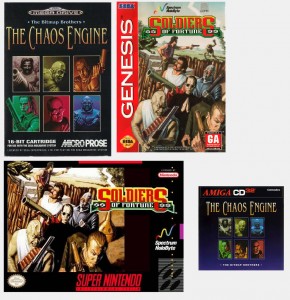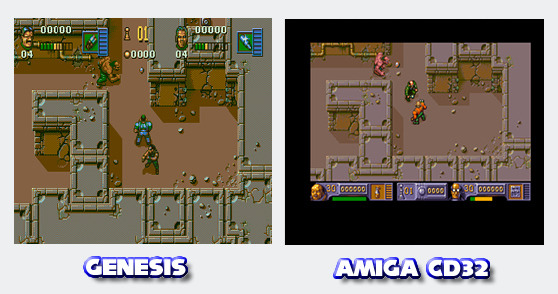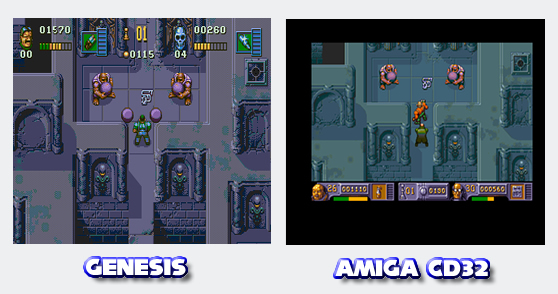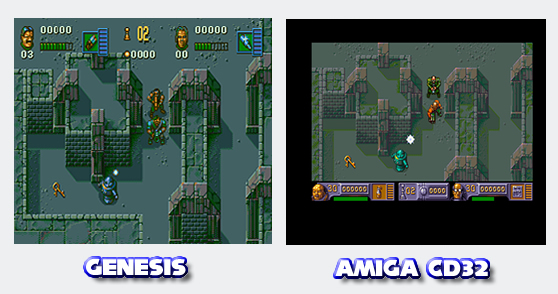The Chaos Engine, – or Soldiers of Fortune, as the ‘Murican SNES and Genesis versions are known as – is a legendary overhead run-‘n-gun by The Bitmap Brothers. It was originally released for the Amiga computer (500 and 1200) in early 1993 and soon ported to the two aforementioned consoles, a few other computer systems, and also the mighty Amiga CD32, probably the best CD-based 32-bit console without 3D graphics released by an American company. Today, we are finally and once and for all deciding which version of The Chaos Engine is actually better – the one on Sega Mega Drive or the one on Commodore Amiga CD32. Let’s get it on!
The Differences
 Presentation: We can spot differences as soon as we see the box art/jewel case insert of the games. At first glance, they seem to be the same, but takinge a closer look, we see two interesting things. On the Mega Drive version, the Gentleman has lost his pipe and the Preacher has lost his collar. In fact, the Preacher changed his job to that of a scientist. This is due to censorship, and the same thing happened to the SNES version.
Presentation: We can spot differences as soon as we see the box art/jewel case insert of the games. At first glance, they seem to be the same, but takinge a closer look, we see two interesting things. On the Mega Drive version, the Gentleman has lost his pipe and the Preacher has lost his collar. In fact, the Preacher changed his job to that of a scientist. This is due to censorship, and the same thing happened to the SNES version.
A side note about the American version of the game: Interestingly, the scientist holds his palms together on the American box art of the game, as if he’s still acting religious. Perhaps the decision of censorship came after that box art had already been drawn, but that didn’t stop them from changing the SNES version’s artwork, which has the held hands removed. One must wonder why the title was changed. Perhaps because the word “Chaos” makes American children overuse their constitutional right to “defend” themselves. Since censorship makes me think of Nazi Germany and the Soviet Union; it is awful and the CD32 scores a good point.
Moving on to the game itself, we’ll take a look at the introduction. The CD32 has a narrated, mostly animated intro of a few splash screens, which look great. The animation tells the story about the experimenter who creates a machine which corrupts any life form it can reach within its grasp. It’s up to the “soldiers of fortune” to end the chaos it causes, the narrator says, and presents the playable characters by name and nothing else. The music, by RIchard JosePh (did you see what I did there?), is quite fitting but a bit too different from the rest of the soundtrack.
The Mega Drive version tells the story with a few screens of text and a single splash screen not presented on the CD32, followed by the characters introduced with some text. Also worth noting is that the theme by Joi (an electronica group) played here, which has the characteristic alarm-sounding techno tintinnabulation, is also used in the Amiga 500 and SNES versions. Here, it sounds distorted, which for some reason makes it even better and more fitting. Ironically, it goes hand-in-hand with the rest of the soundtrack, which was composed by the aforementioned RIchard JosePh. Though the Mega Drive has the better music in its intro, the CD32 makes up for it with its narration and animation.
The manual of the game is printed on paper for the Mega Drive and is included within the game itself for the CD32, much like modern games have started to do. The Mega Drive manual has a few more languages, including Swedish, and is more detailed as well. I prefer printed manuals so I can read it comfortably without having to turn the game on.
The Mega Drive version of the game has an options screen, which the CD32 is lacking. It has sounds tests for music and sound effects, but all tracks aren’t there. Lame. To sum up the presentation, the Mega Drive has the better intro music and better manual, as well as an options screen, while the CD32 has a great animation intro and lacks censorship. Putting all together, we get a fair tie.
EDGE: Tie
Graphics: The game takes place in a steampunk setting with an overhead view. It’s not particularly advanced, but it gets the job done and has the right feel to it. The enemy design tends to feel uninspired sometimes, but the gritty environments and the animation make up for it. Both versions live up to these previous lines of the paragraph, but there are mainly two differences to acknowledge as well.
First off, we have the colour. The CD32 shines well in this area. While the pixelart is the same, the environments of the game look brighter and have a good contrast to the sprites. On the Mega Drive, not so much. The CD32 has more palettes for the sprites. Instant win for the CD32 right? Hold on a minute. Even though the CD32’s colours look better by themselves, you also see less of them. What do I mean? The graphics are inside a black box on the screen (as if there are letter box bars on all sides). The Mega Drive has full-screen graphics. Also, the bottom of the CD32 screen is completely dedicated to the player stats. While it looks good, it needs to be said that this statistics field decreases the playfield even more, and this adds a problem to the gameplay. Enemies often seem to jump right at you from outside the screen, which is unfair and annoying. It seems to happen because the view shows much less than the actual active environment around you. I didn’t notice this problem on the Mega Drive. The Mega Drive uses sprites at the top of the screen to show health, special powers etc. I’ve read people prefer the Mega Drive version of Zombies Ate My Neighbors over the SNES version because the stats are in the way in the playfield in the SNES version. This problem, I cannot see in The Chaos Engine, so I think using the stats directly on the playfield instead of a bar at the bottom is preferred. Adding the better colour of the CD32 together with the better playfield of the Mega Drive, we get a tie in graphics.
EDGE: Tie
Sound: The soundtrack is some minimalist bizarro techno, which for some strange reason fits the steampunk setting like a hand in a glove. Except for the intro tunes, the tracks themselves are, some rearrangement disregarded, the same in both games. Of course, they sound different.
In terms of quality, if you can measure quality by whether the music uses sampled instruments or not (which some people tend to do), the CD32 wins easily. It uses the four channel PCM chip known as Paula, perhaps the greatest soundchip for sampled music of all time. Some instruments seem sampled, and some synthesized (Paula can actually do that too). Then again, it mostly sounds weaker than the Mega Drive, which has a thicker sound, a rougher feel and more “OMPHTZZ!!” in the drums (especially in the first world). I think this fits the unpolished setting of the game better, and it sounds better too. The CD32 has two CDDA tracks (in addition to the intro and the ambient sound effects), which definitely sound better compared to their Mega Drive counterparts, but they are just the menu and shop themes and you don’t hear them as much as the in-game music. One thing worth noting when listening to the sample files is that the CD32 sounds a bit better here, since the left and right channel separation is removed, making it sound stronger.
I didn’t take much note about the sound effects, but the voice samples are, of course, of higher quality on the CD32, though the Mega Drive does a good job. There are some ambient sound effects on the Mega Drive, and plenty more, of higher quality, on the CD32. Given that the Mega Drive has overall slightly better music (I may be going to hell for this, but whatever, it’s so bloody cold here anyway) and the CD32 has better ambient effects and samples, the result is a tie.
Chaos Engine (Mega Drive): World 1 Level 1 Theme
Chaos Engine (CD32): World 1 Level 1 Theme
EDGE: Tie
Gameplay: The gameplay of both versions is virtually the same. All characters, levels, weapons, and power-ups are there. Both games use passwords, which work the exact same but aren’t interchangeable between versions. The health bars for the players are countable on the Mega Drive, but it doesn’t really matter. Another issue matters more: the one and only boss at the end of the game has a health bar on the CD32, which is actually quite helpful. It helps you decide if it’s worth the risk to stand and point-blank him or not. On the Mega Drive, there is no health bar on the boss, so you have to take the chance, and I died a few times at the boss doing just that.
There are other things that differ. The Mega Drive has three different difficulty settings (which for some idiotic reason has hard as the default). The CD32 has none. Still, the CD32 is harder than the Mega Drive’s hard setting. This is not just because of slightly more and faster enemies but also because of the smaller view and the controller, which we will get to now.
Here comes the biggest difference in gameplay, which cannot be blamed on the game developers – the joypads of the systems. The Mega Drive’s official six-button controller is a prime example of excellence in design and ergonomics. The Amiga CD32 controller is but a torture device… well, at least for your left thumb. It physically hurts after just a few minutes of play, at least it does for me. This makes a HUGE impact on the game experience, especially since you need to use diagonals and aim carefully in this game. That is much harder to do with the CD32 pad. “But wait, Zebbe, don’t you know there is also a Competition Pro brand gamepad for the CD32”, you say? Yes, I know, and I have it. The Competition Pro pad is like a mix of the three 16-bit console pads: the shape and D-pad of the three-button Mega Drive controller, the button layout of the SNES, and the turbo switches of the TurboGrafx-16. It’s a good step up from the original CD32 controller, but it’s still light years away from the glory of the official six-button controller of the ol’ Blast Processor. “But wait, Zebbe, don’t you know you can use the Mega Drive pads on the Amiga,” you say? Yes, I know, and I did. And The Chaos Engine immediately becomes a better experience, all thanks to Sega. The problem then is only one button works, so you need to tap B to shoot and hold it to activate your special power. Pausing, changing special power, or using the AI’s special power cannot be done; however, the game is still beatable with the Mega Drive pad. And YES, I know you can modify a pad to make all buttons work, but that’s cheating and like saying “Oh yeah? I overclocked my SNES, so I have blast processing too now!” It’s going too far and just doesn’t count.
A few others things are worth mentioning. The CD32 has loading times. They are most notable when you start up the game but aren’t much of an issue, really. The Mega Drive game has a bit more slowdown,but it happens pretty much only when there are many enemies on screen at the same time, which isn’t that often. I played both versions in 50 Hz.
Since the Mega Drive has difficulty settings and doesn’t have the controller issues, it easily takes the gameplay. The health bar on the CD32 boss is too minor an issue to give it an edge here, and while I do prefer harder games, the CD32 gains it partially from its flaws, so it won’t give an edge either. Slowdown and loading times are minor issues that don’t change things much.
EDGE: Mega Drive
Final Assessment
I love both my Mega Drive and my Amiga CD32, and both versions of The Chaos Engine are great. They are a bit different in all aspects, which is just fine. In an era where all ports are virtually the same, it is nice to see how consoles from back in the day had different strengths and weaknesses, which gave their games unique aspects. While you can’t go wrong with either version, the Mega Drive takes a slight edge over CD32 thanks to something so simple as the controller. It is said the Amiga 500 version of the game is the absolute best one. If I get to play it someday, or any other version, I might revise this comparison.
Text revision, sound and graphics material by: Barone
VS. screen Photoshop by: Lync (also thanks to Kamahl and EyeDeeNo76)




Always like seeing platform comparisons. The differences between European and North American box art was interesting too.
Great article 🙂
Thank you very much :).
Great Article, I love the comparison between platforms. You should explore this venue more often : )
Keep it up!
Thank you! We’ll see what happens. I always have a million small projects going on, most of which end up unfinished unfortunately.